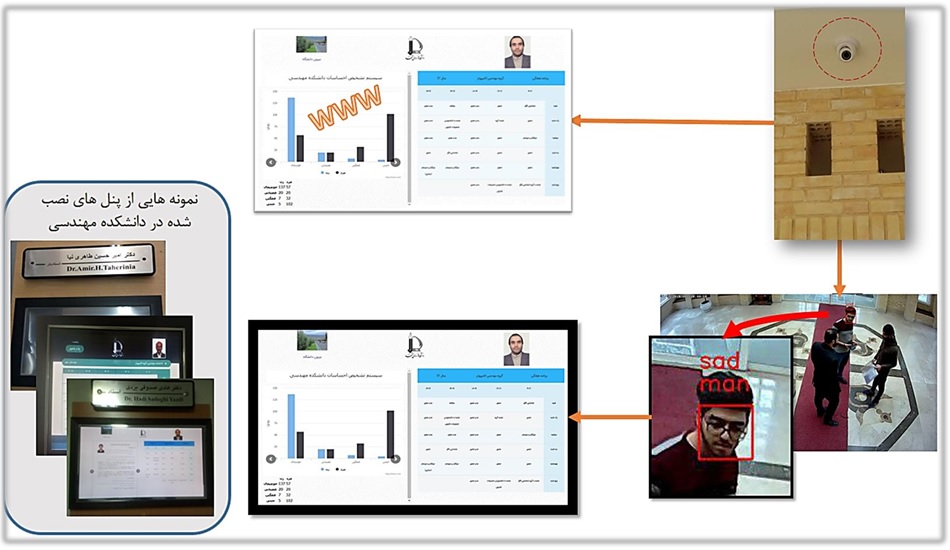Real-Time Emotion Detection System
The Real-Time Emotion Detection System is an innovative solution designed to classify human emotions in real-time using advanced computer vision and machine learning techniques. By analyzing facial expressions, body language, and other visual cues, this system provides immediate insights into emotional states such as happiness, sadness, or anger, enabling applications in mental health, human-computer interaction, and behavioral analysis.
Left to right: Camera Unit, Real-Time Emotion Processing, Monitoring Dashboard

Key Features and Benefits
This system leverages cutting-edge technology to deliver impactful features for real-time emotion analysis:
- Real-Time Emotion Classification: Detects and classifies emotions instantly using deep learning algorithms, enabling immediate feedback for dynamic applications.
- Comprehensive Visual Analysis: Captures and processes facial expressions, gestures, and body language for accurate emotion recognition.
- Continuous Monitoring: Tracks emotional states over time, supporting longitudinal analysis and real-time interventions.
- Data Storage and Analysis: Stores emotion data for trend analysis, model improvement, and reporting, ensuring scalability and adaptability.
- User-Friendly Interface: Provides a dashboard for visualizing emotional states, suitable for professionals in psychology and human-computer interaction.
Applications and Impact
The system supports a wide range of applications with significant societal benefits:
- Mental Health Monitoring: Assists clinicians in tracking emotional changes for early intervention in mental health conditions.
- Human-Computer Interaction: Enhances interactive systems, such as virtual assistants, by adapting responses based on user emotions.
- Behavioral Research: Provides researchers with real-time data for studying emotional responses in various contexts.
- Customer Experience: Improves service delivery in industries like retail by analyzing customer emotions in real-time.
Technical Specifications
- Camera Unit: High-resolution cameras with real-time video capture capabilities for precise visual data collection.
- Processing Module: Employs deep learning models (e.g., convolutional neural networks) for on-device or cloud-based emotion analysis.
- Communication: Secure data transmission using encrypted protocols to protect sensitive information.
- Data Storage: Robust database system for storing images, emotion classifications, and timestamps, optimized for longitudinal analysis.
- Monitoring Dashboard: Web-based interface compatible with desktop and mobile devices, offering real-time visualizations and alerts.
Research and Development
Developed by the Pattern Recognition Laboratory at Ferdowsi University of Mashhad, this system builds on advanced research in computer vision and affective computing to ensure reliability and scalability.
Background and Importance
Understanding human emotions in real-time is critical for applications in mental health, education, and interactive technology. This system addresses the growing need for automated, accurate emotion detection to support affective computing and improve human well-being.
Project Implementation
The system integrates several components for seamless operation:
- Camera Unit: Captures high-quality video frames or images of subjects, focusing on facial expressions and body language.
- Real-Time Recognizer: Processes visual data using machine learning models to classify emotions with high accuracy.
- Monitoring Module: Continuously tracks emotional states, providing real-time updates and alerts.
- Data Storage: Aggregates and stores data for future analysis, model retraining, and reporting.
- Dashboard: Displays emotion trends and alerts, enabling users to monitor and act on emotional insights.
Challenges and Solutions
- Accuracy in Diverse Conditions: Advanced algorithms account for varying lighting, angles, and cultural differences in emotional expression.
- Privacy Concerns: Local processing and encrypted data transmission ensure user privacy and compliance with data protection standards.
- Scalability: Cloud or on-device processing options allow deployment across various environments, from single-user setups to large-scale systems.
Conclusion
The Real-Time Emotion Detection System is a transformative tool for understanding and responding to human emotions. By integrating IoT, computer vision, and machine learning, it provides actionable insights for mental health, research, and interactive applications, fostering a more empathetic and responsive technological landscape.
